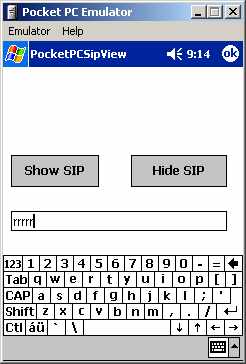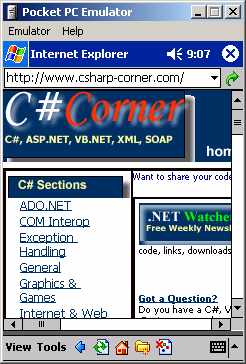When you get your hands on a Pocket PC for the first time you have to wonder just how the heck do you enter information? Well as you will see in this article Pocket PC has something called a SIP or Soft Input Panel. The idea is you click a button at the bottom of the screen and up pops a miniature QWERTY keyboard which when used enters information into an active control like a textbox.
Now this is useful but how to use it from a C# project? If I was programming in Embedded Visual Basic 3.0 or eVB I could set a property called sipvisible to true and magically the SIP would appear on screen. Currently on the compact framework nothing similar exists so we have to call into our friends the WIN32 set and specifically call SipShowIM from coredll.
As you can see from this code its pretty straightforward to do this and results in a simple program that allows us to display the SIP and enter text into the textbox.
Here is what the application runs like on my Pocket PC emulator:

At this point I have pressed the Show SIP button and clicked into the textbox and then am able to click on letters in the SIP keyboard to enter data. Of course pressing the Hide SIP button hides the SIP again.
In previous articles I stressed not to use the Pocket PC emulator for testing your code all the time but of course this is exactly what I am doing now. I did say however that with each release of the Pocket PC development tools the emulator gets better.
So just for fun I launched the Pocket Internet Explorer and of course with a few clicks I was reading www.c-sharpcorner.com on a Pocket PC emulators Pocket Internet Explorer! Here is the screenshot in case you think I am lying :)

So as if C#.NET was not cool enough, now you have a new platform to run it on in the form of Pocket PC and all its derivatives. Of course as we are still in beta of the compact framework things will change over the next few releases but it is looking very impressive and of course I am not having to learn anything new over what I have learnt on the full .NET to create mobile applications.
//PocketPCSIPView.cs
//Shows how to hide and display the SIP on a Pocket PC
//Written May 19th by John O'Donnell - [email protected]
using System;
using System.Windows.Forms;
using System.Runtime.InteropServices;
namespace PocketPCSIPView
{
/// <summary>
/// Summary description for Form1.
/// </summary>
public class Form1 : System.Windows.Forms.Form
{
[ DllImport("coredll.dll")]
private static extern bool SipShowIM(int dwFlag);
private System.Windows.Forms.Button button1;
private System.Windows.Forms.Button button2;
private System.Windows.Forms.TextBox textBox1;
private System.Windows.Forms.MainMenu mainMenu1;
public Form1()
{
}
protected override void Dispose( bool disposing )
{
base.Dispose( disposing );
}
#region Windows Form Designer generated code
/// <summary>
/// Required method for Designer support - do not modify
/// the contents of this method with the code editor.
/// </summary>
private void InitializeComponent()
{
this.mainMenu1 = new System.Windows.Forms.MainMenu();
this.button1 = new System.Windows.Forms.Button();
this.button2 = new System.Windows.Forms.Button();
this.textBox1 = new System.Windows.Forms.TextBox();
//
// button1
//
this.button1.Location = new System.Drawing.Point(8, 88);
this.button1.Size = new System.Drawing.Size(88, 32);
this.button1.Text = "Show SIP";
this.button1.Click += new System.EventHandler(this.button1_Click);
//
// button2
//
this.button2.Location = new System.Drawing.Point(128, 88);
this.button2.Size = new System.Drawing.Size(96, 32);
this.button2.Text = "Hide SIP";
this.button2.Click += new System.EventHandler(this.button2_Click);
//
// textBox1
//
this.textBox1.Location = new System.Drawing.Point(8, 144);
this.textBox1.Size = new System.Drawing.Size(216, 20);
this.textBox1.Text = "";
//
// Form1
//
this.ClientSize = new System.Drawing.Size(240, 270);
this.Controls.Add(this.textBox1);
this.Controls.Add(this.button2);
this.Controls.Add(this.button1);
this.Menu = this.mainMenu1;
this.Text = "PocketPCSipView";
}
#endregion
static void Main()
{
Application.Run(new Form1());
}
//Show the SIP
private void button1_Click(object sender, System.EventArgs e)
{
SipShowIM(1);
}
//Hide the SIP
private void button2_Click(object sender, System.EventArgs e)
{
SipShowIM(0);
}
}
}